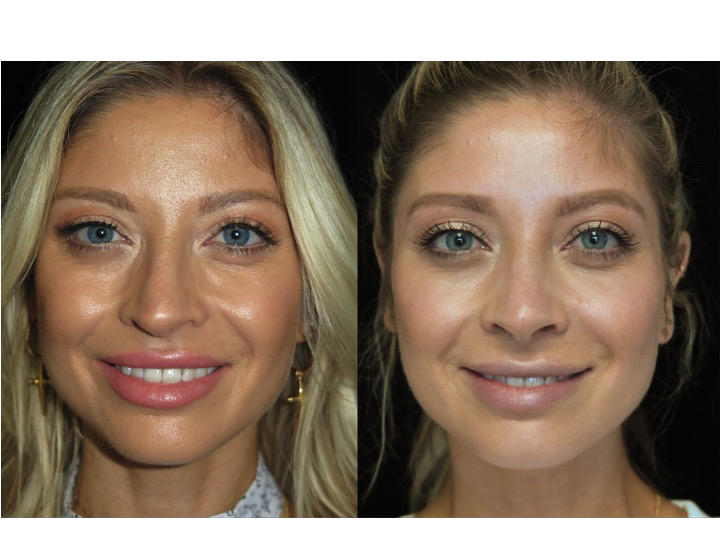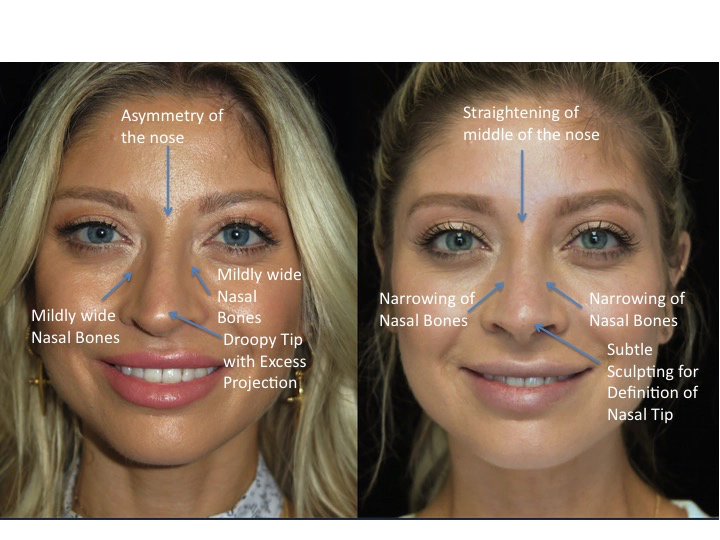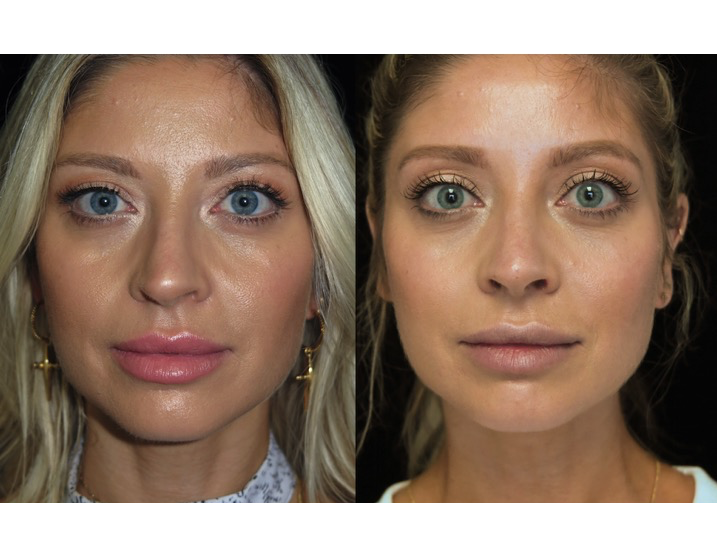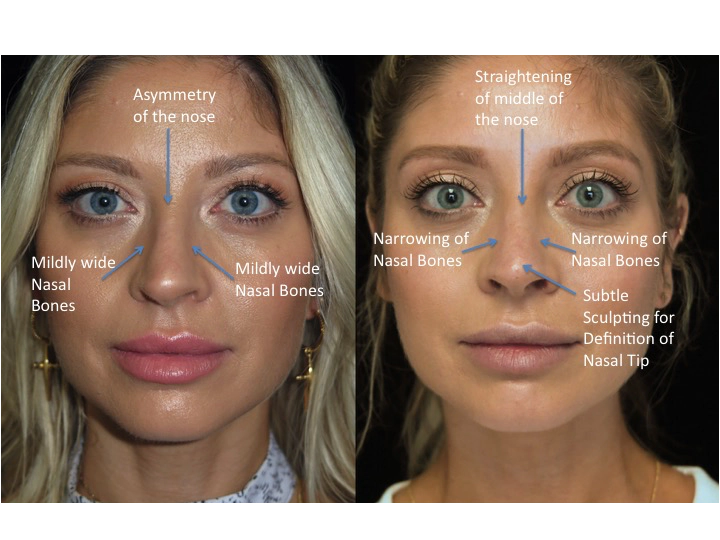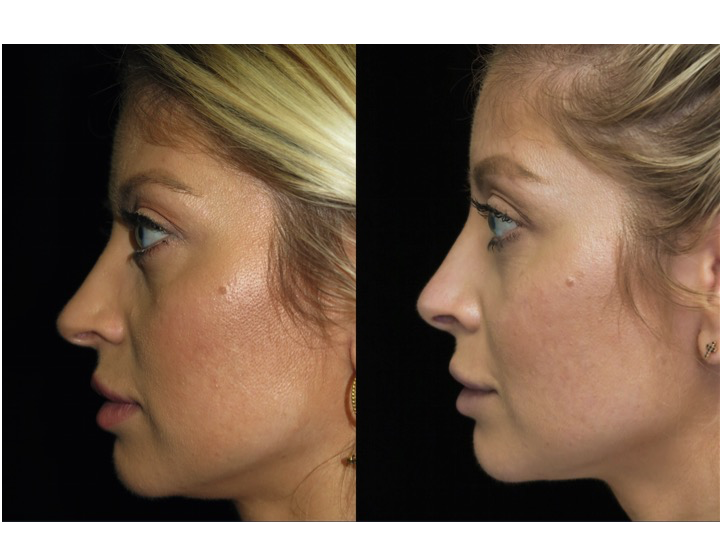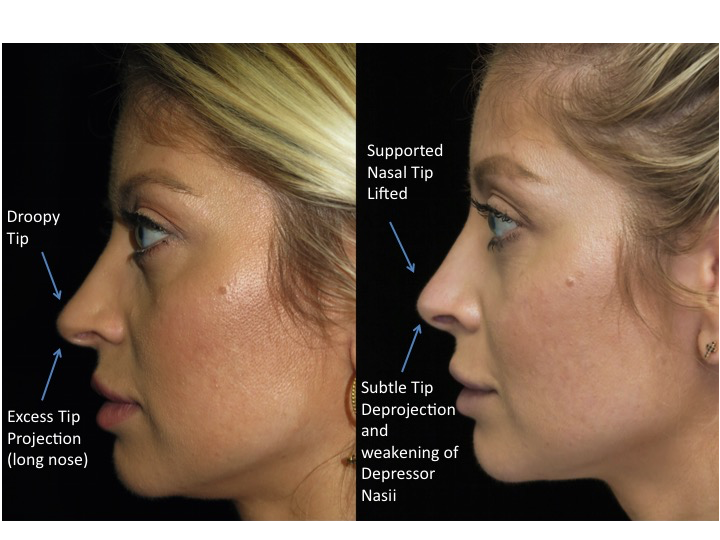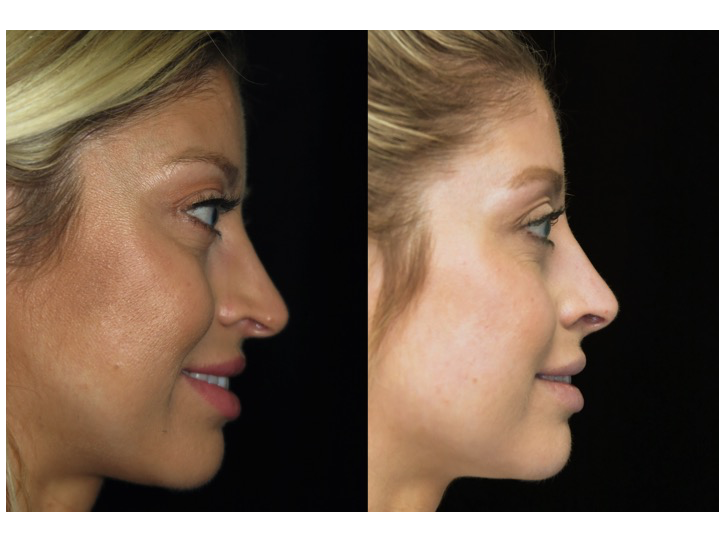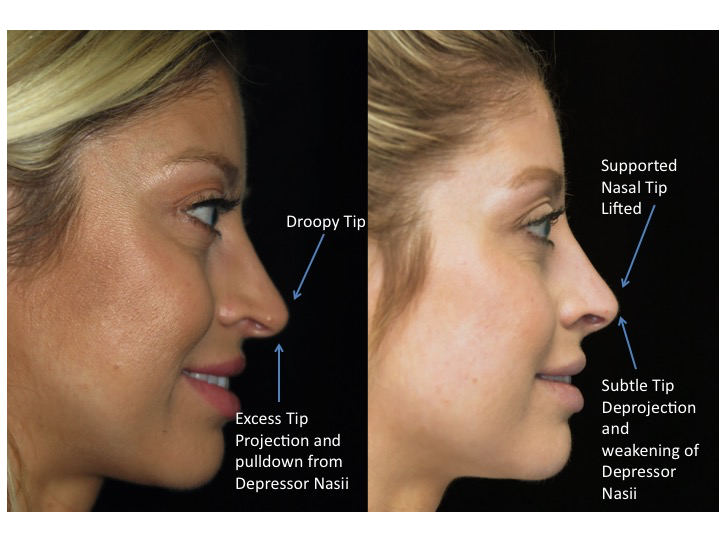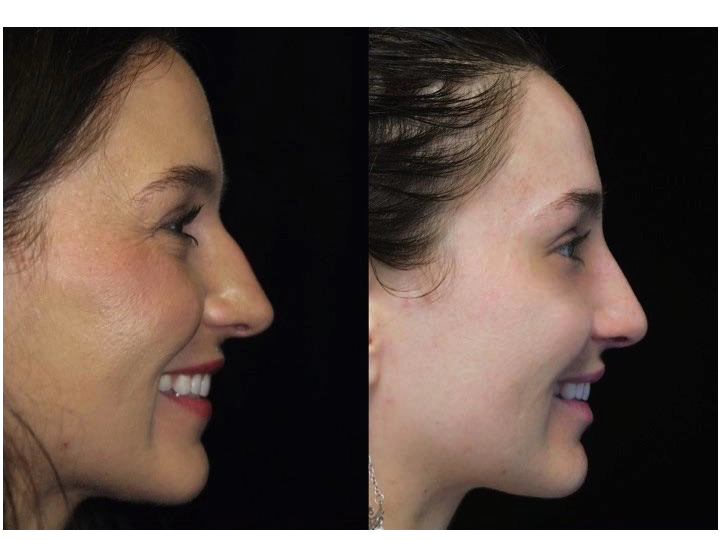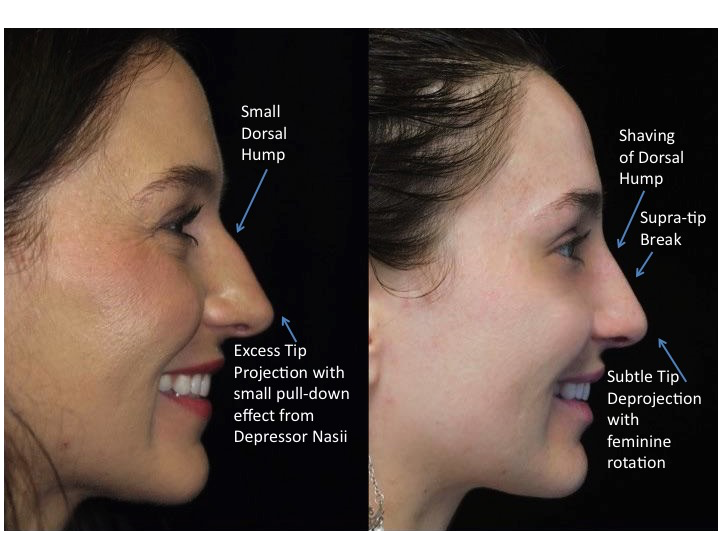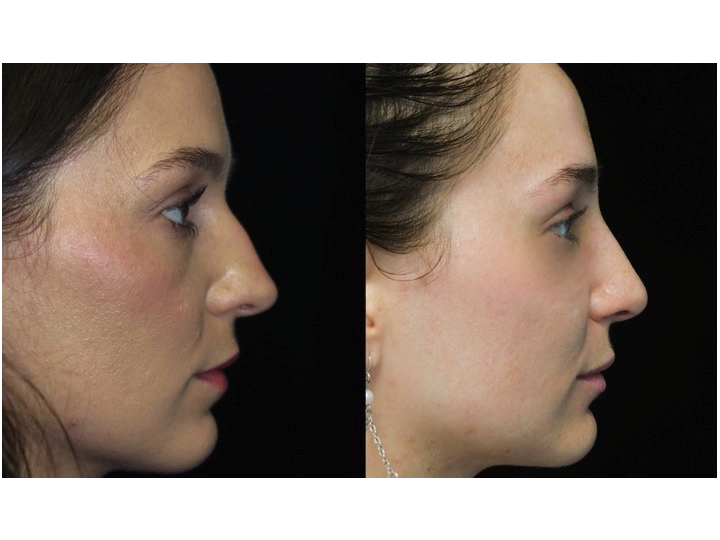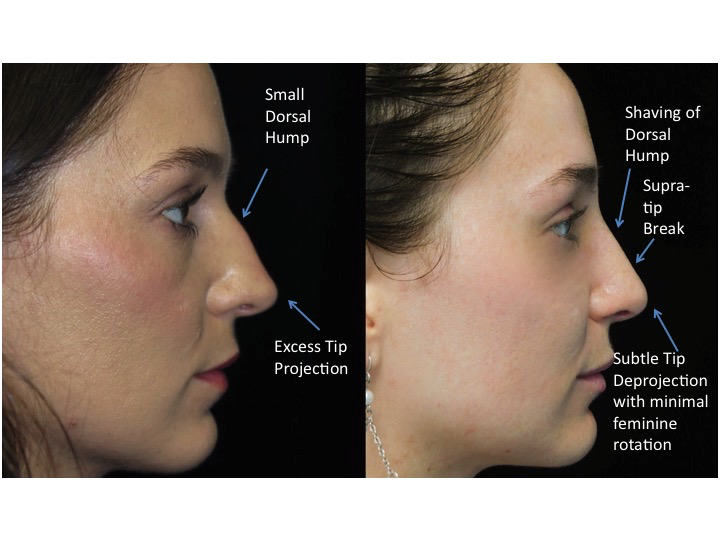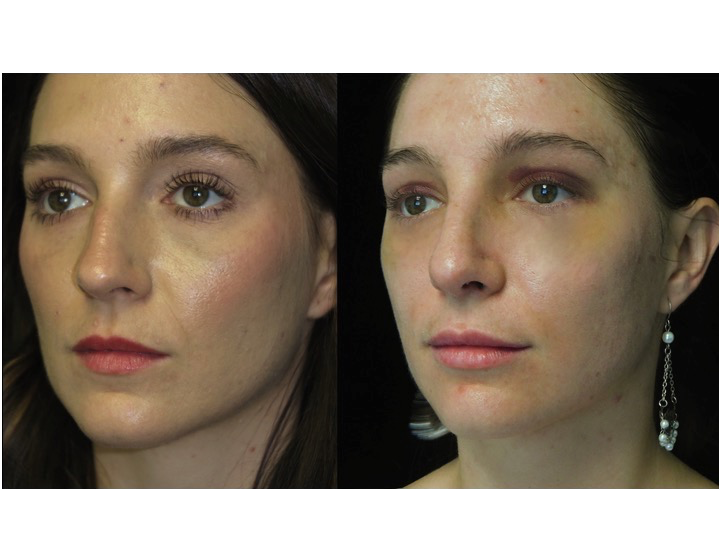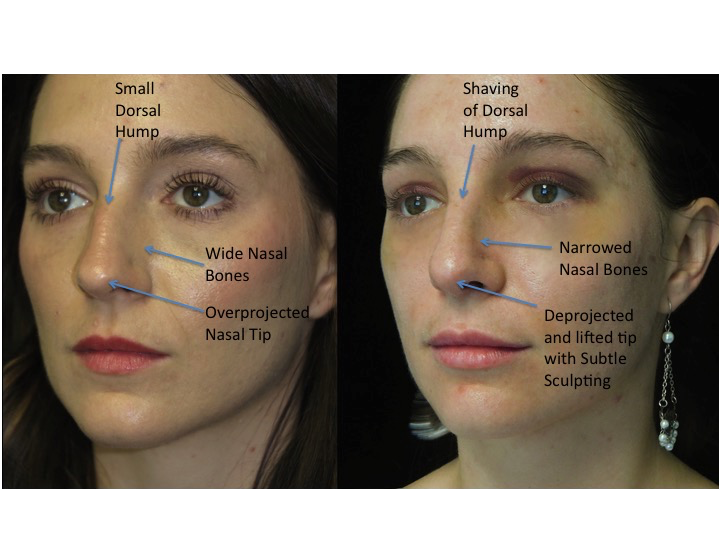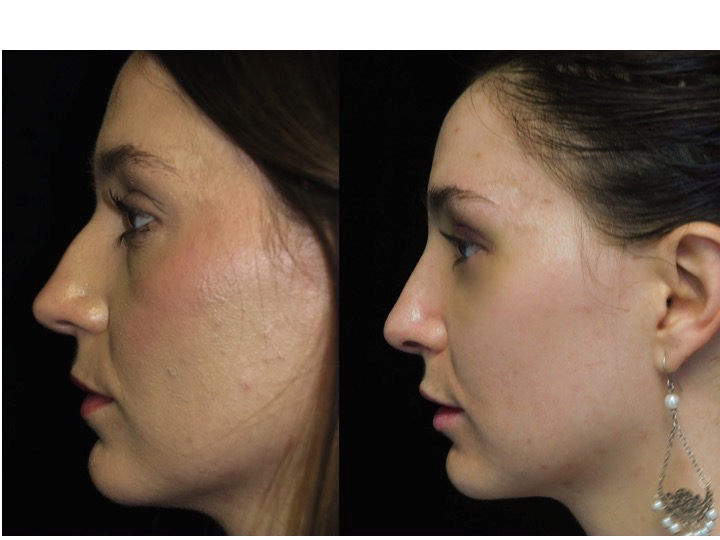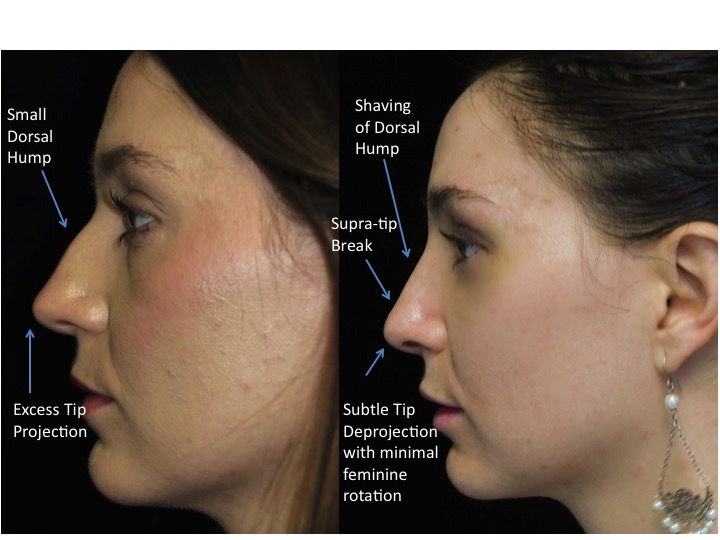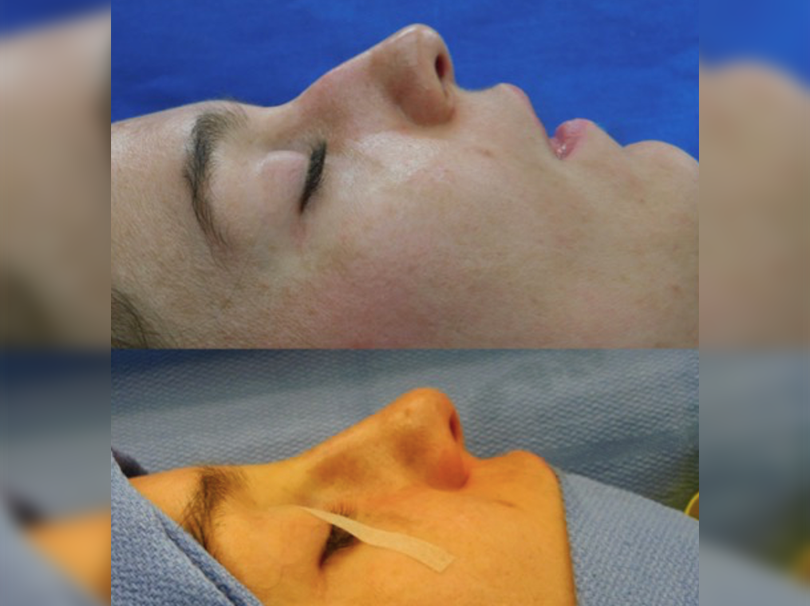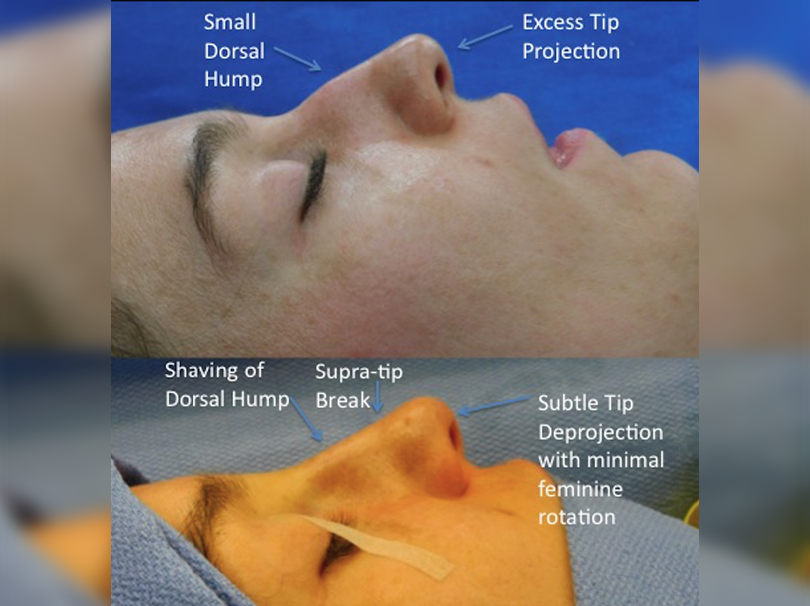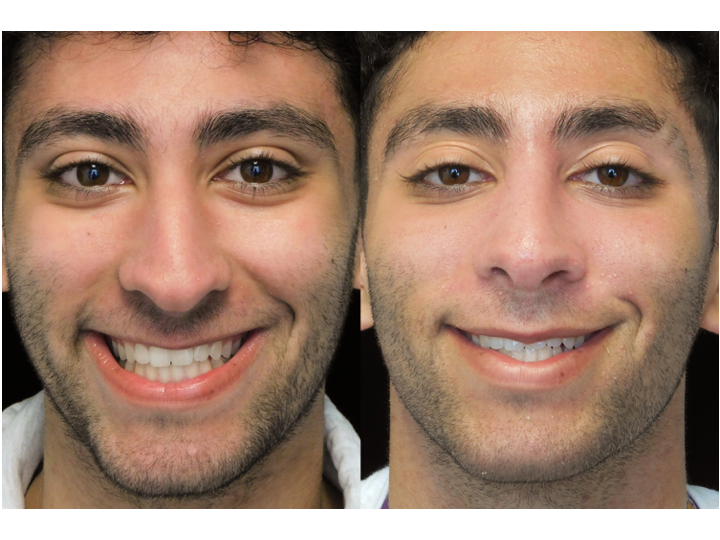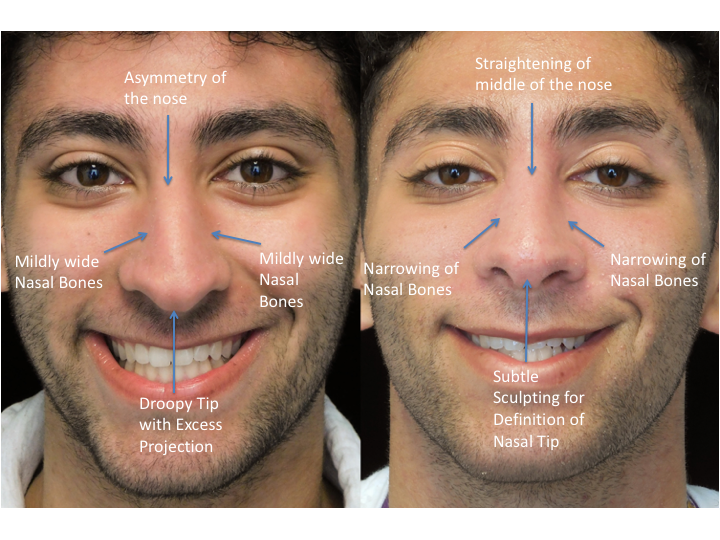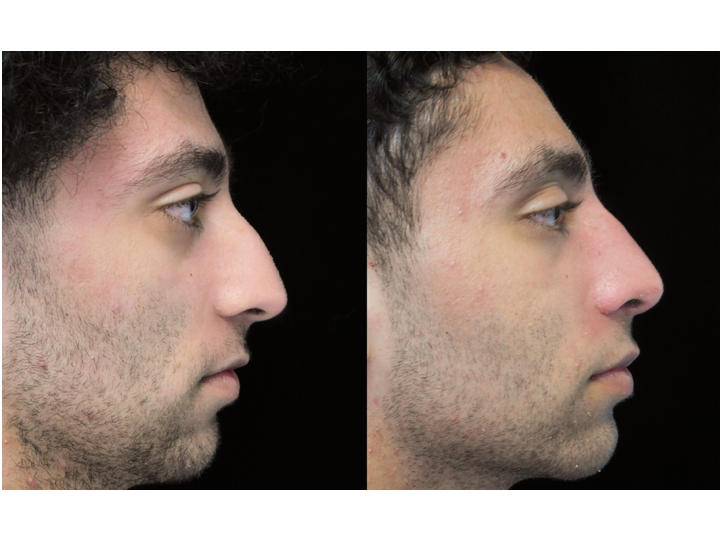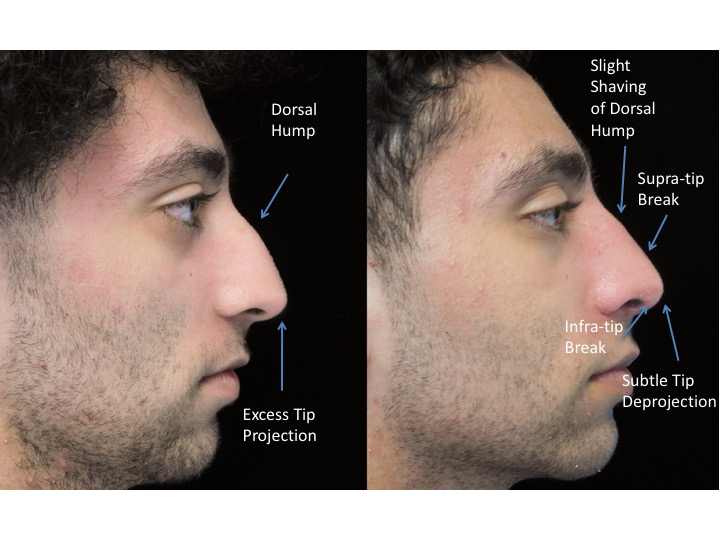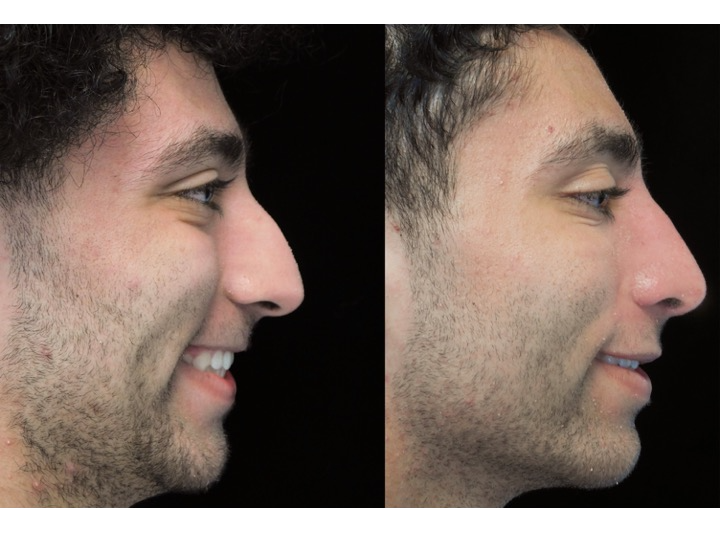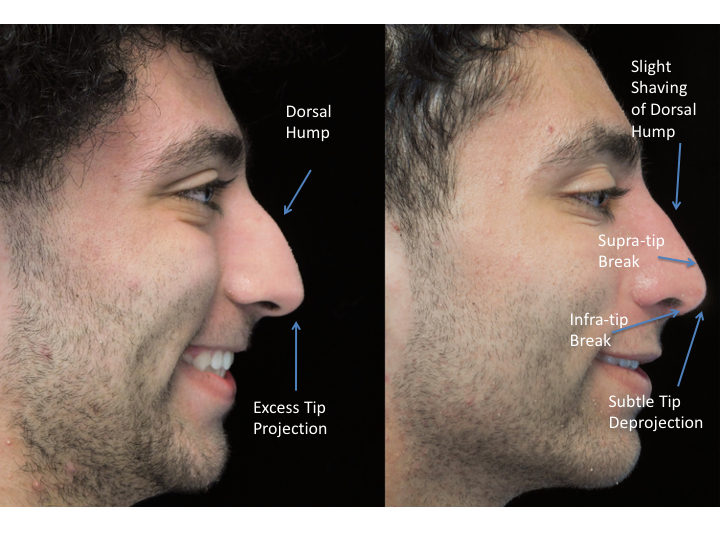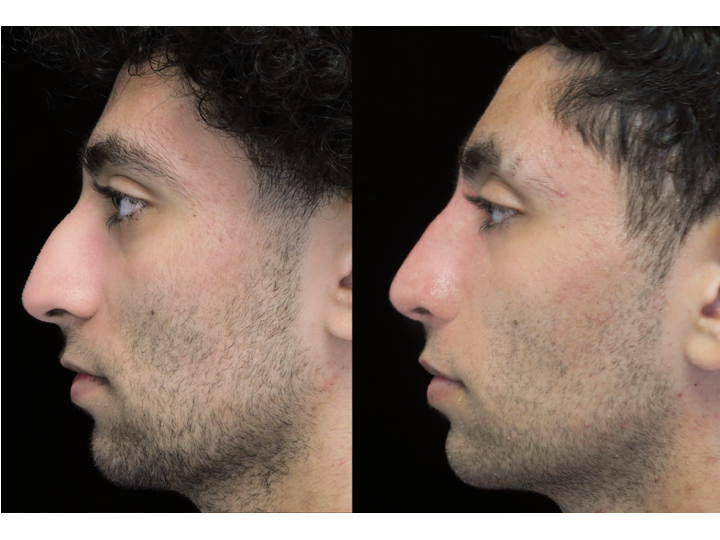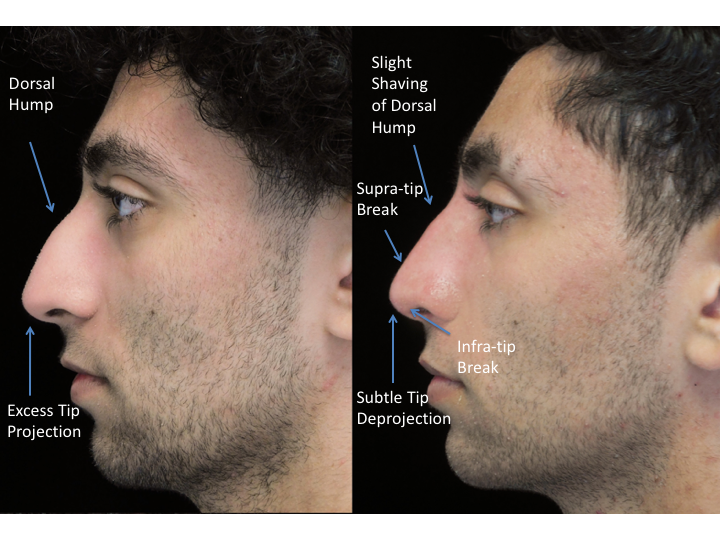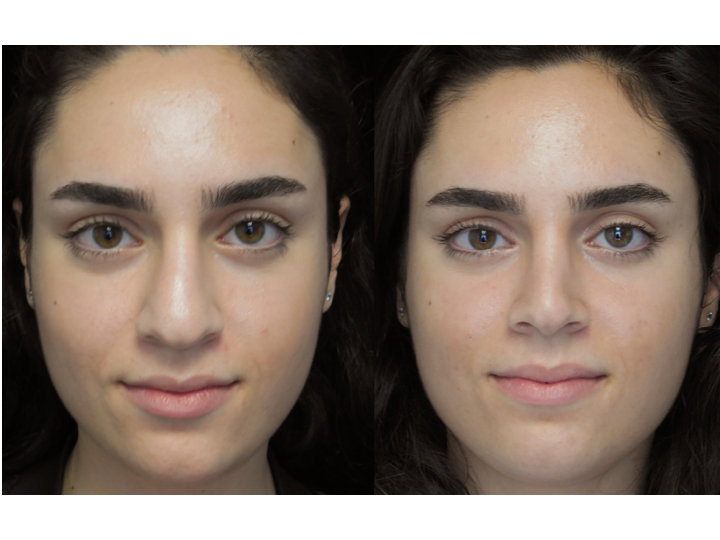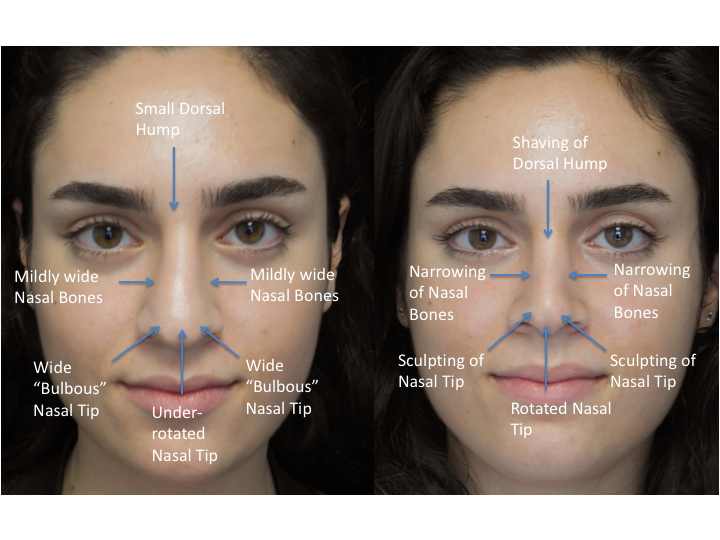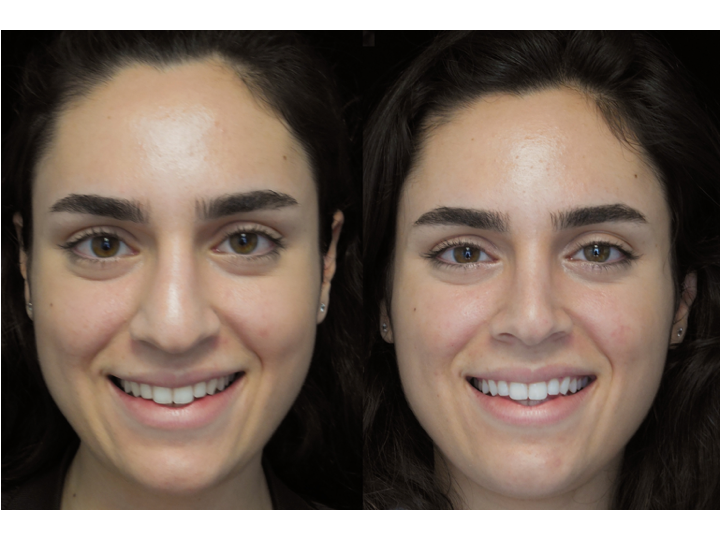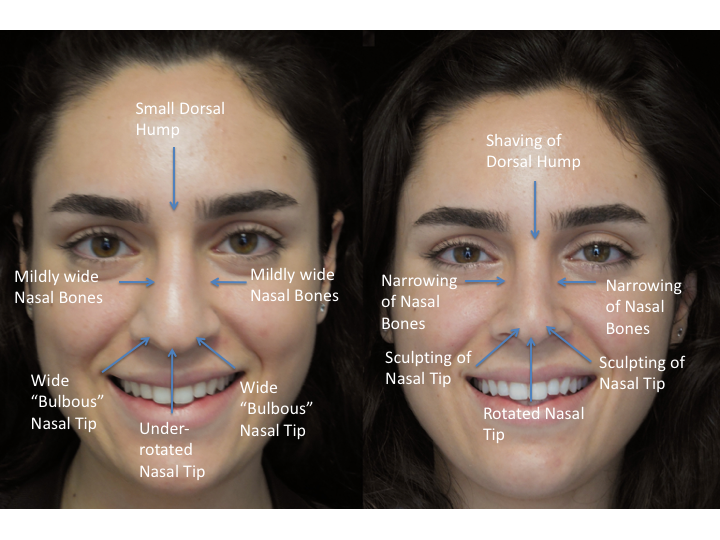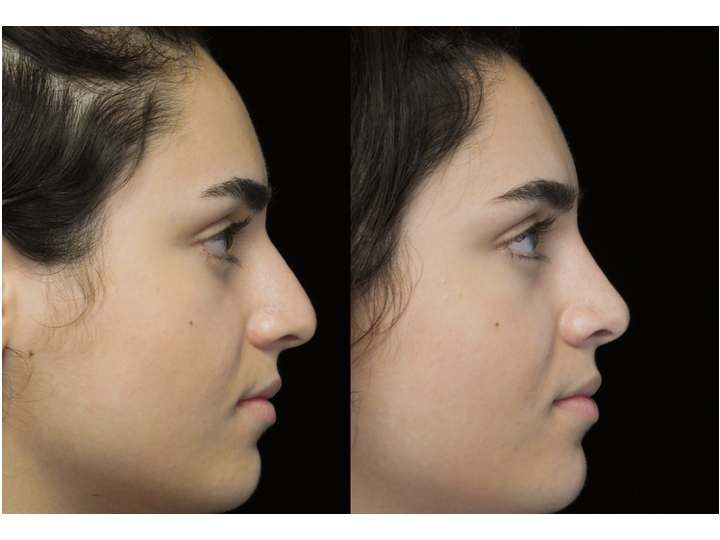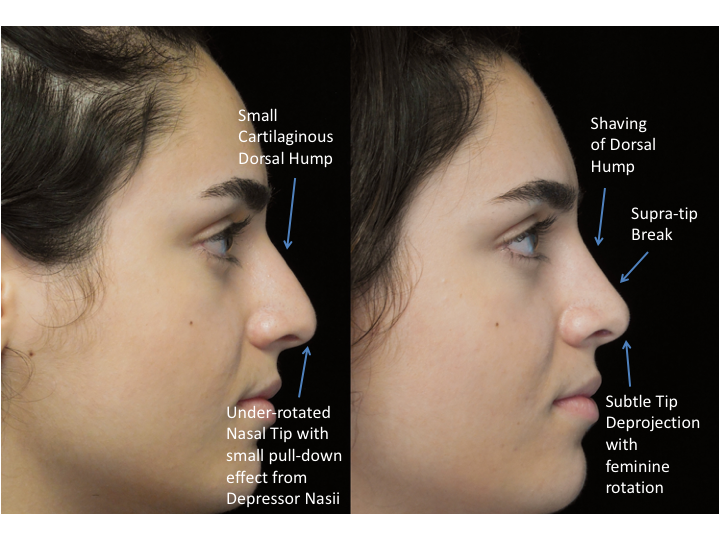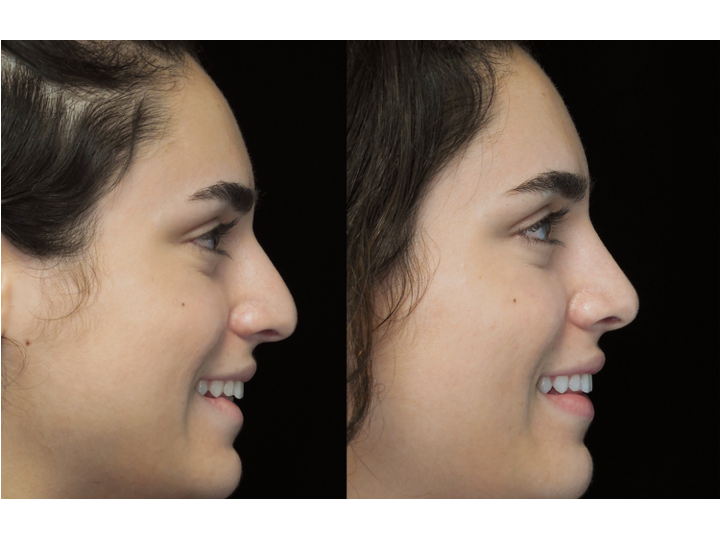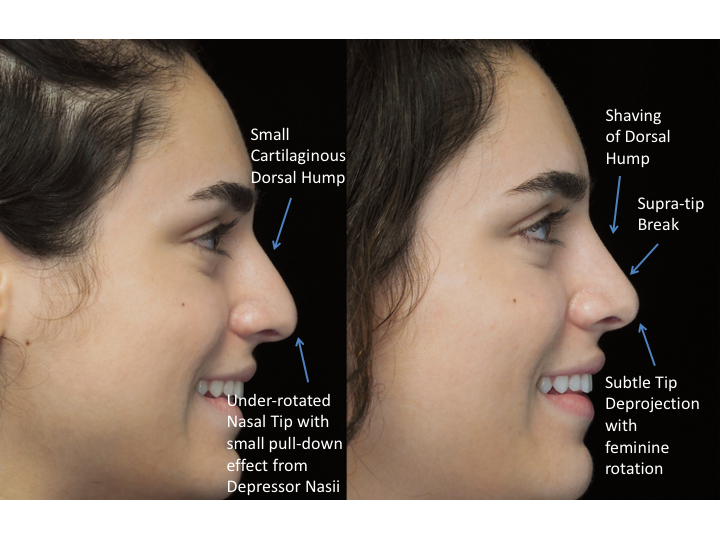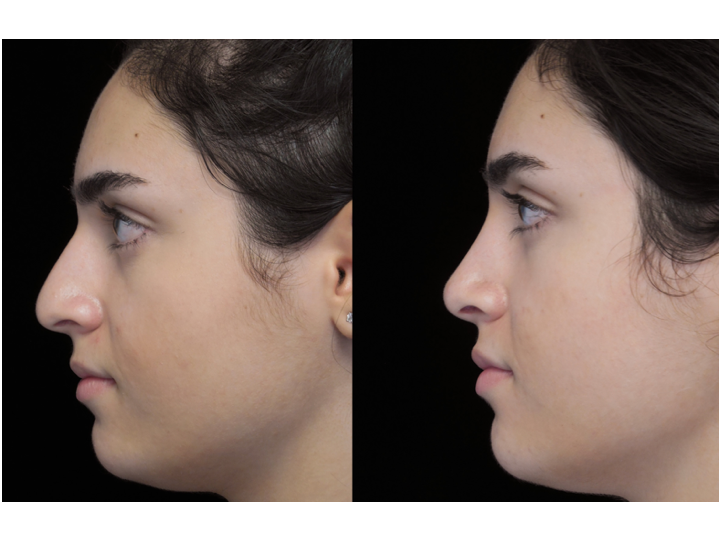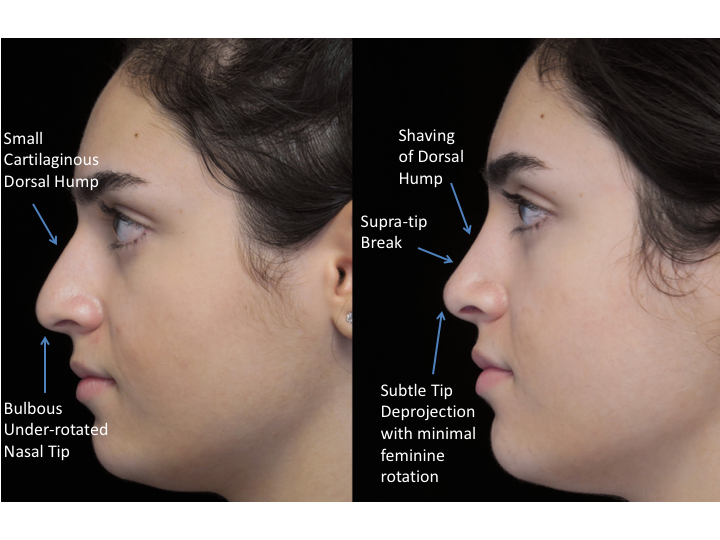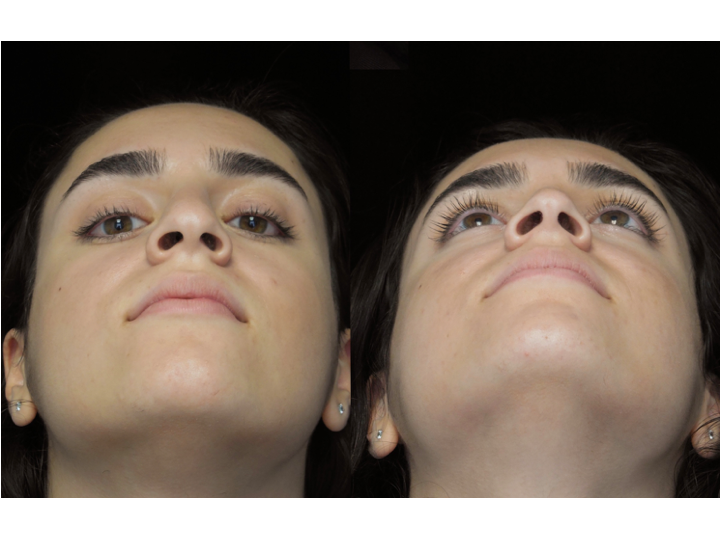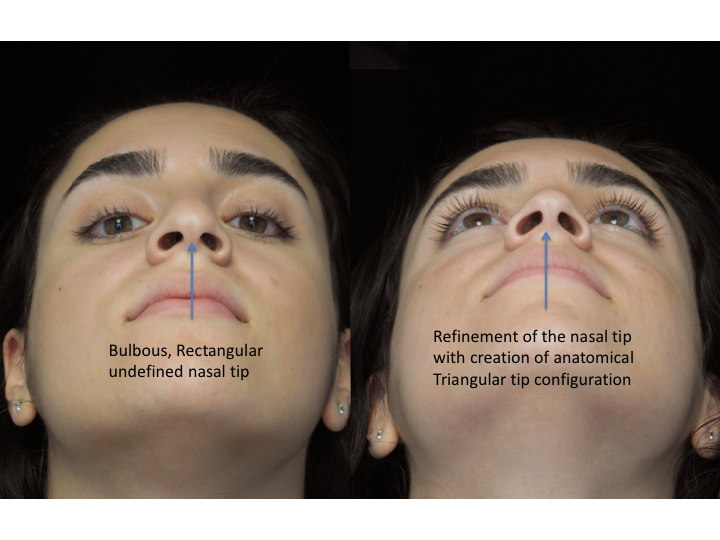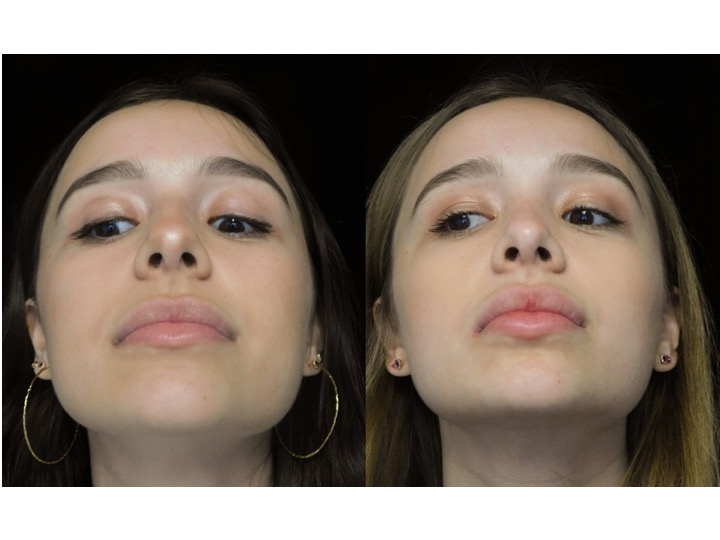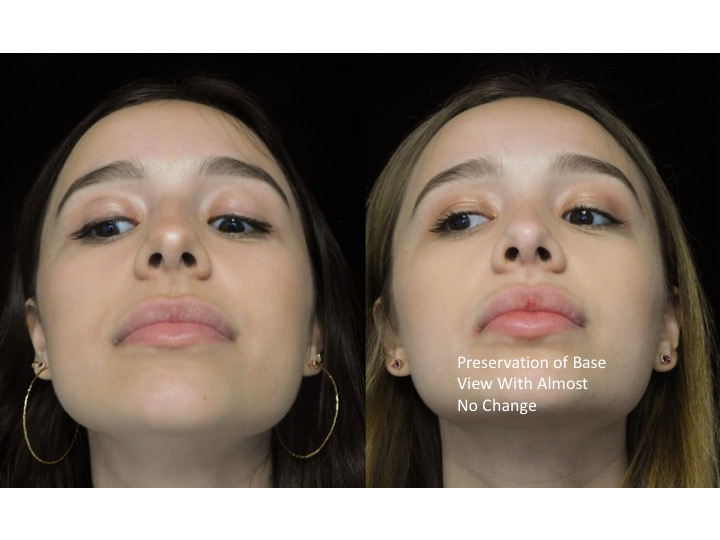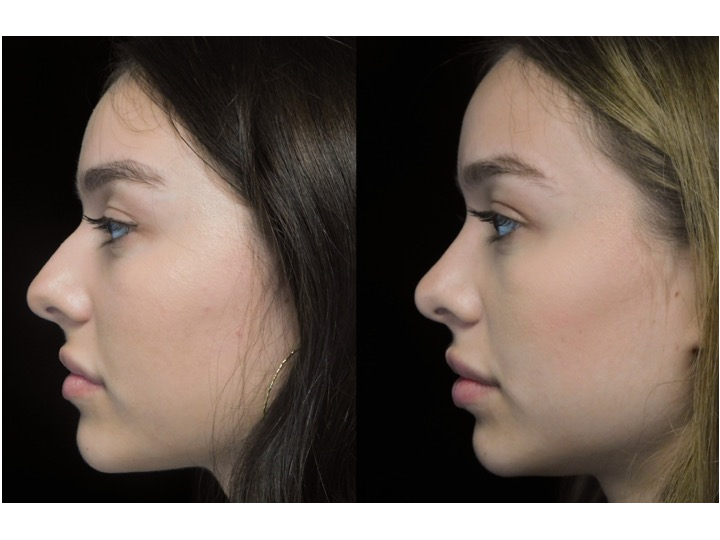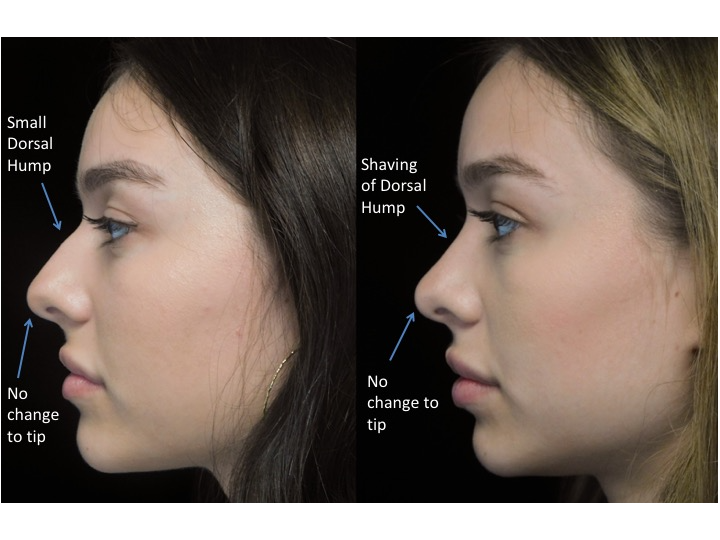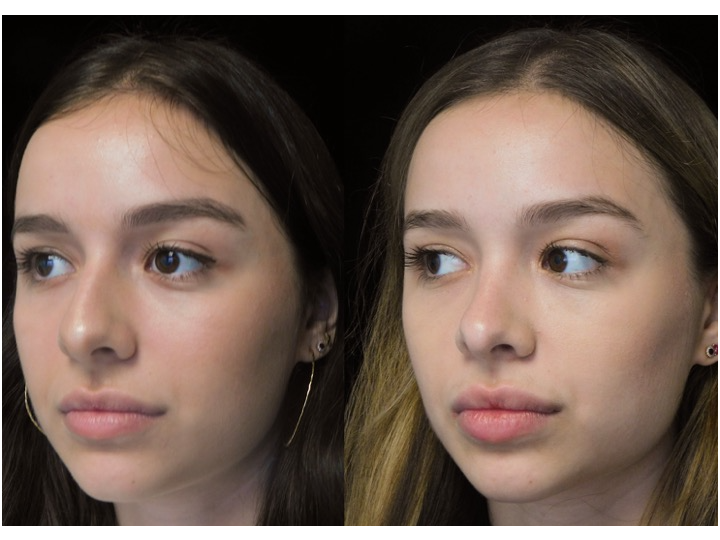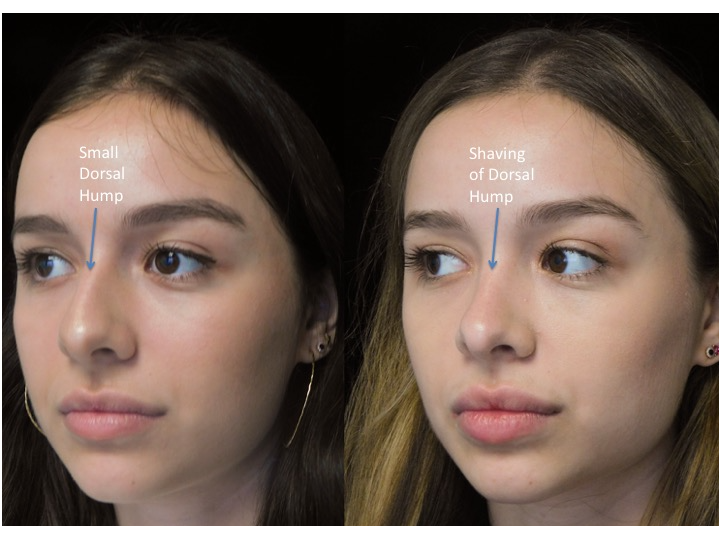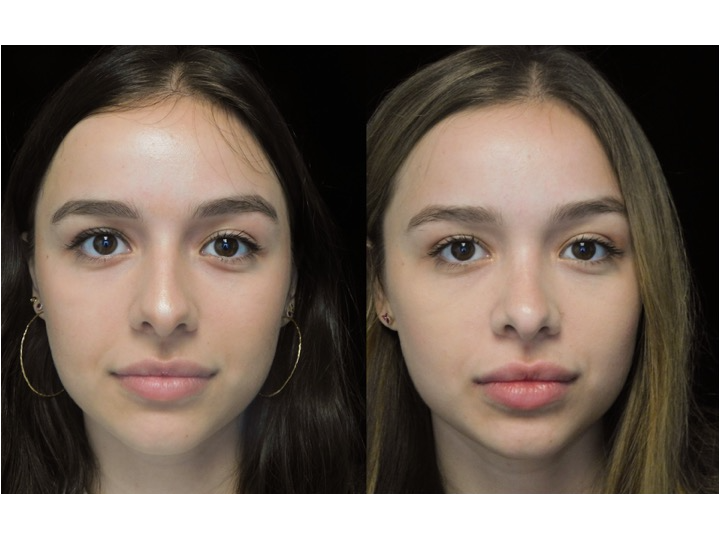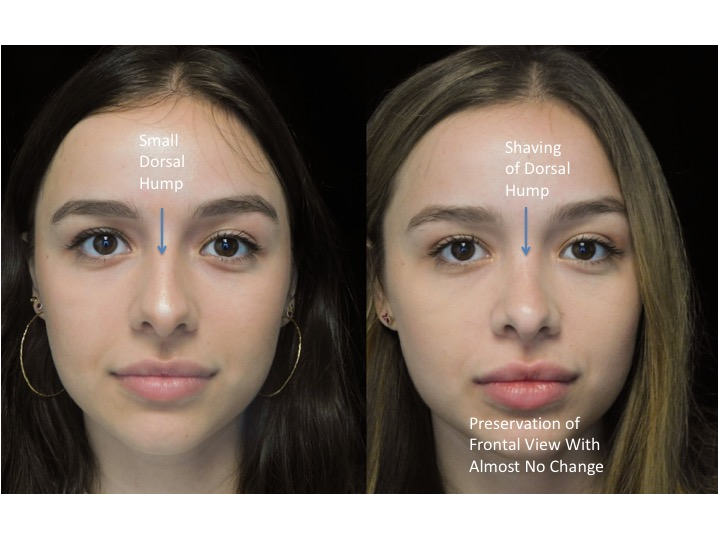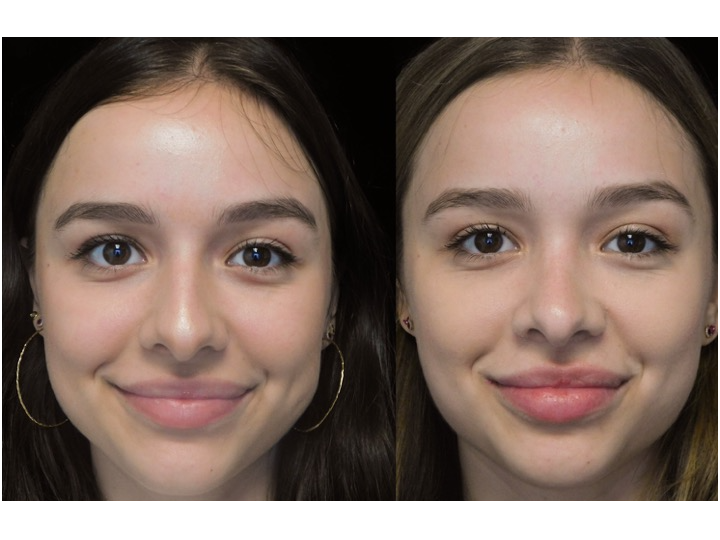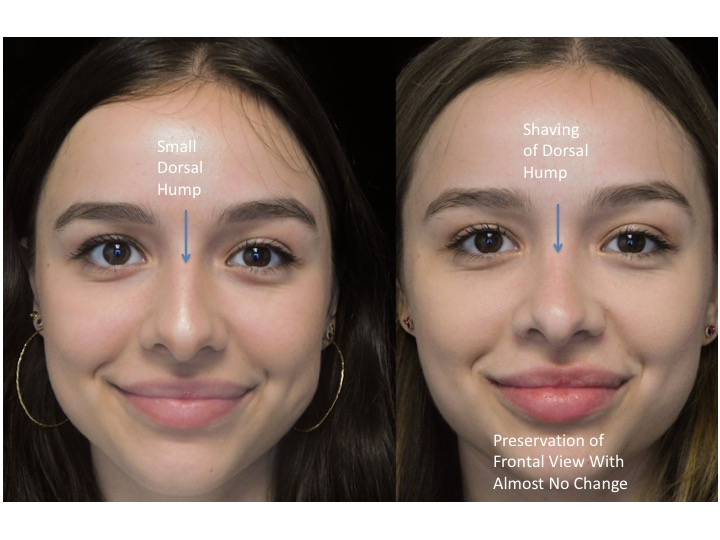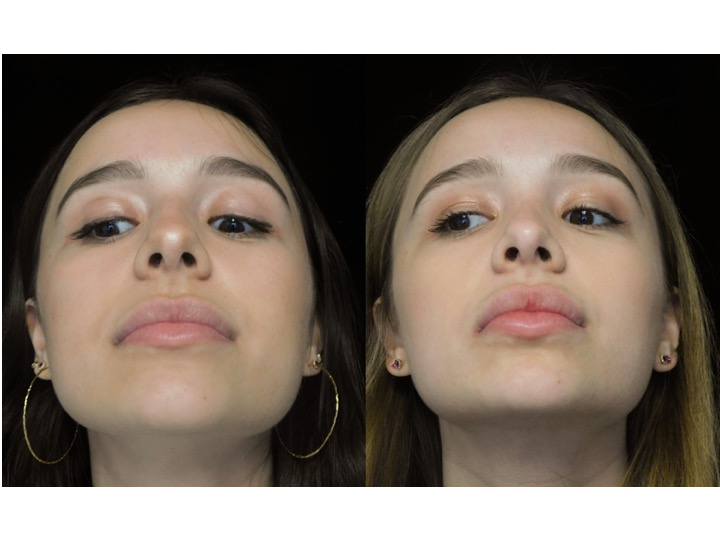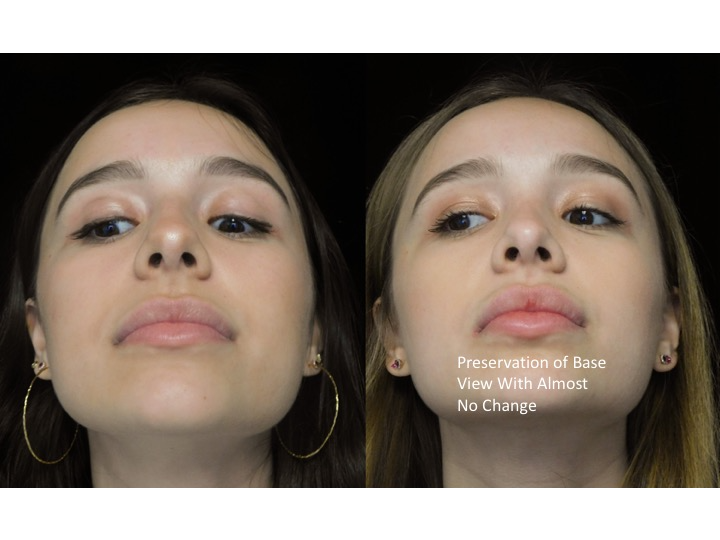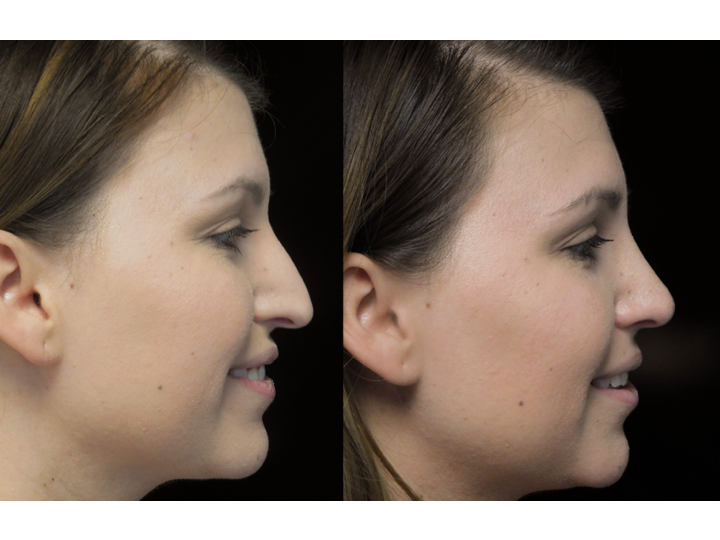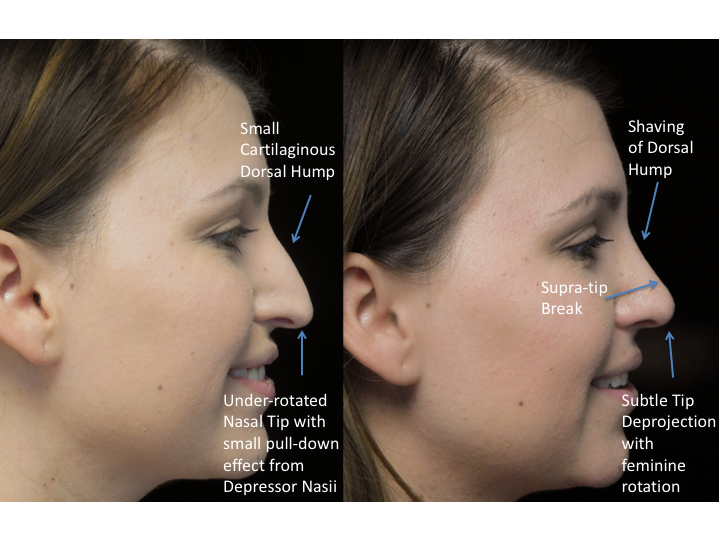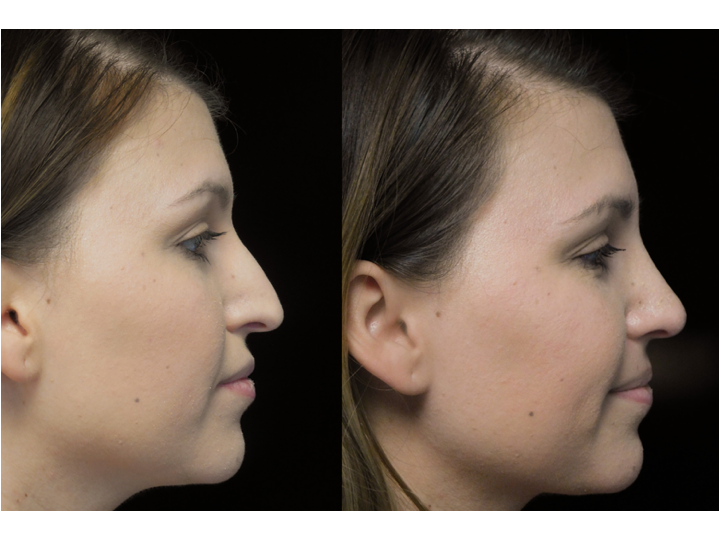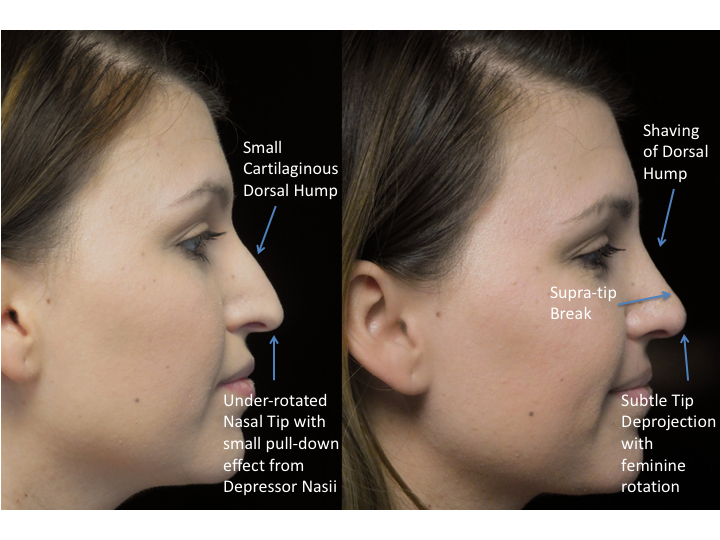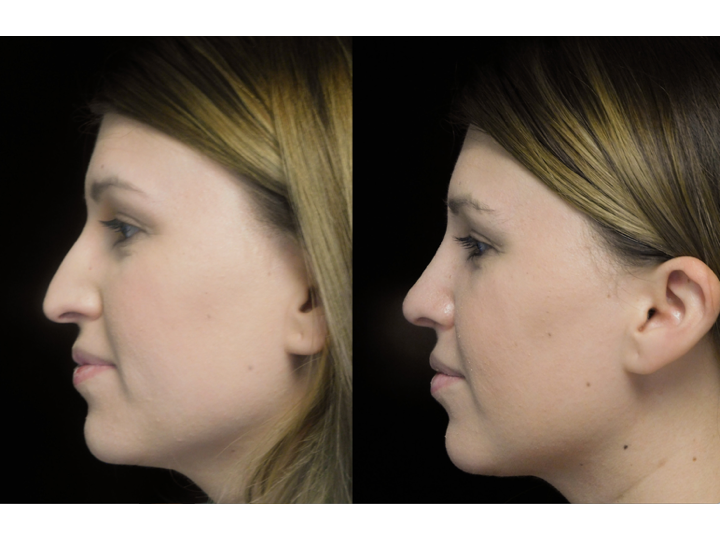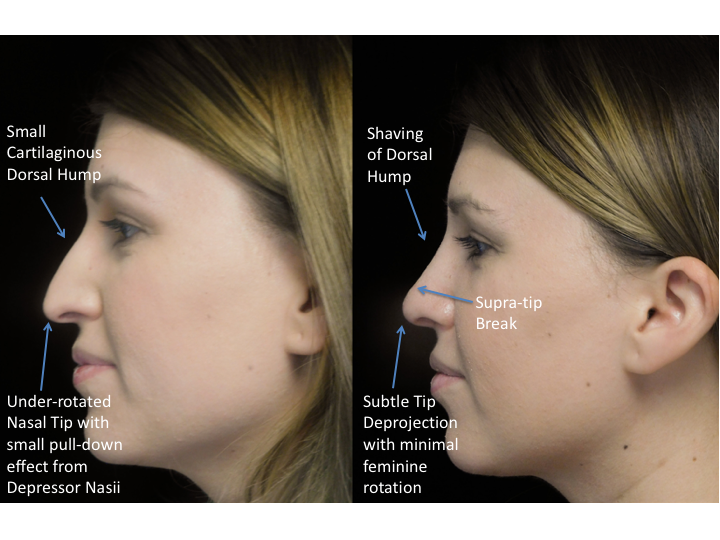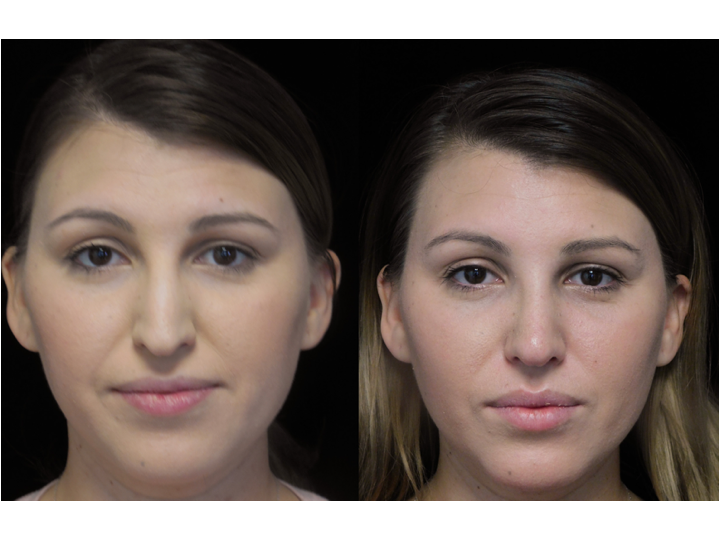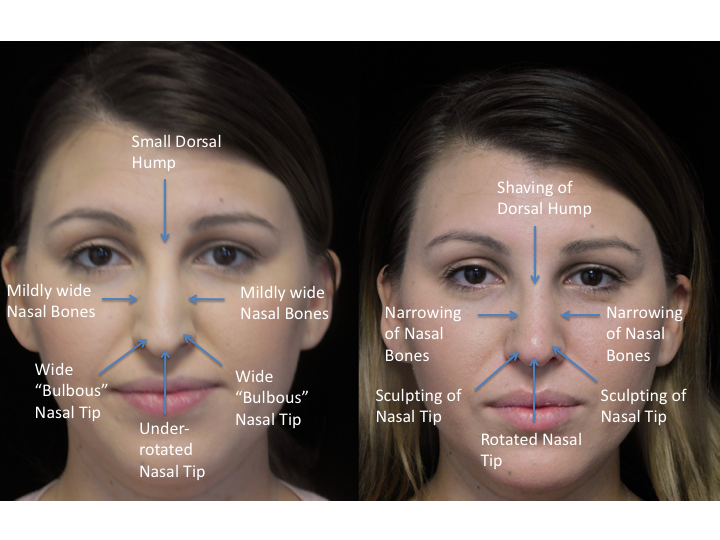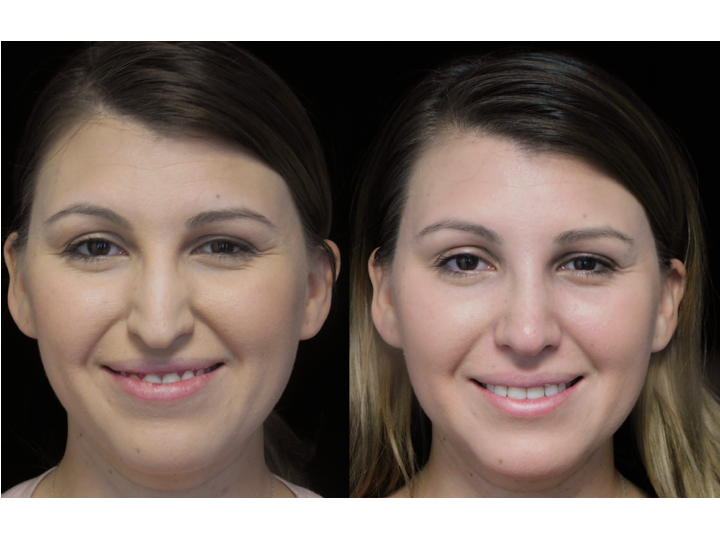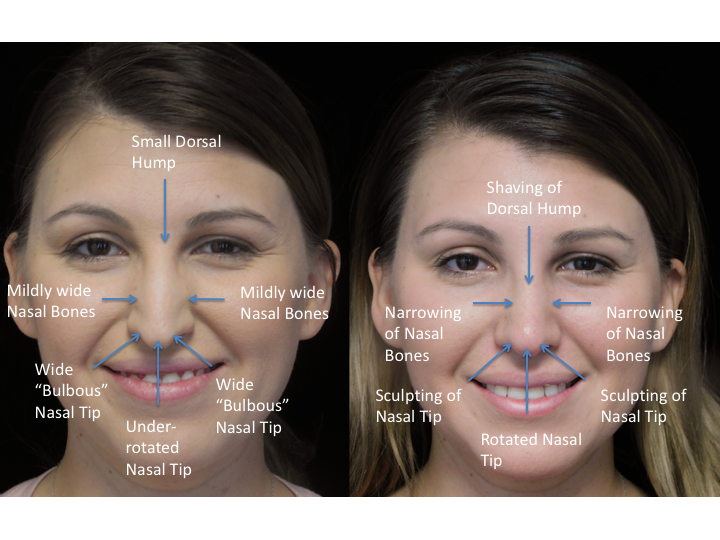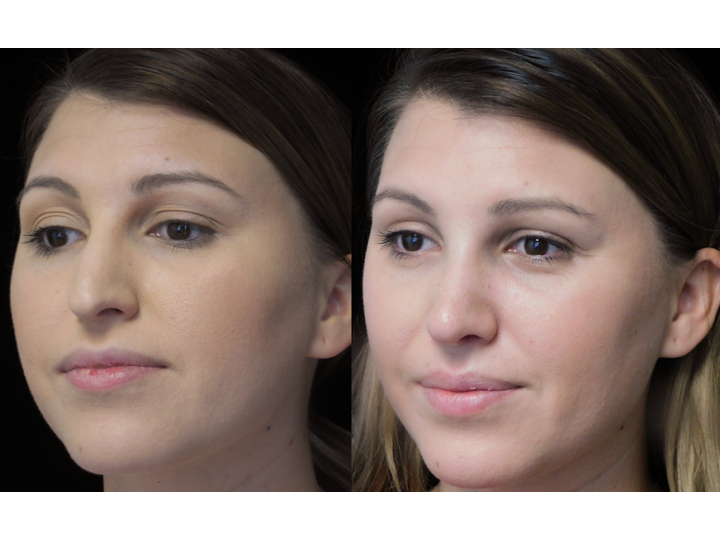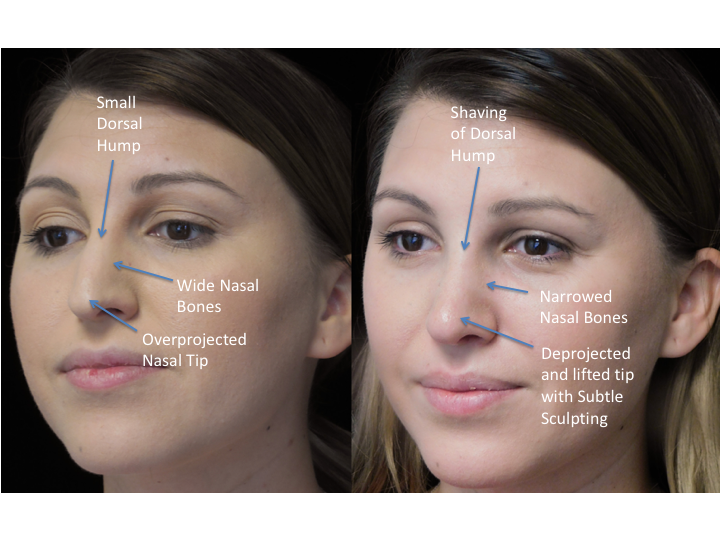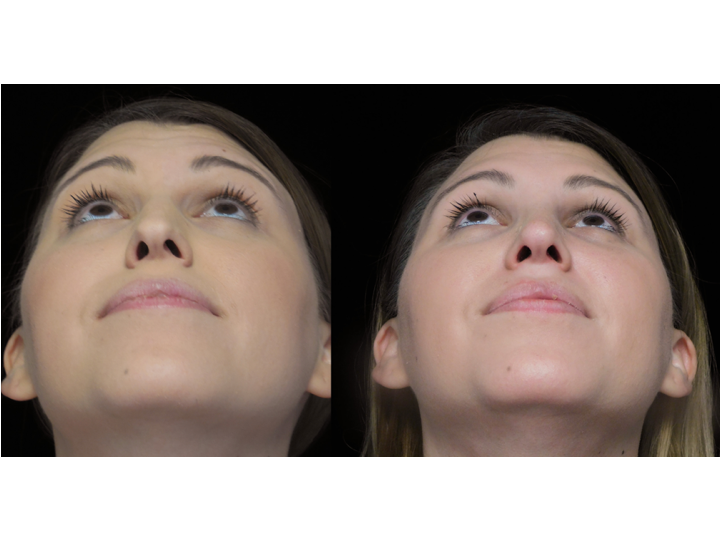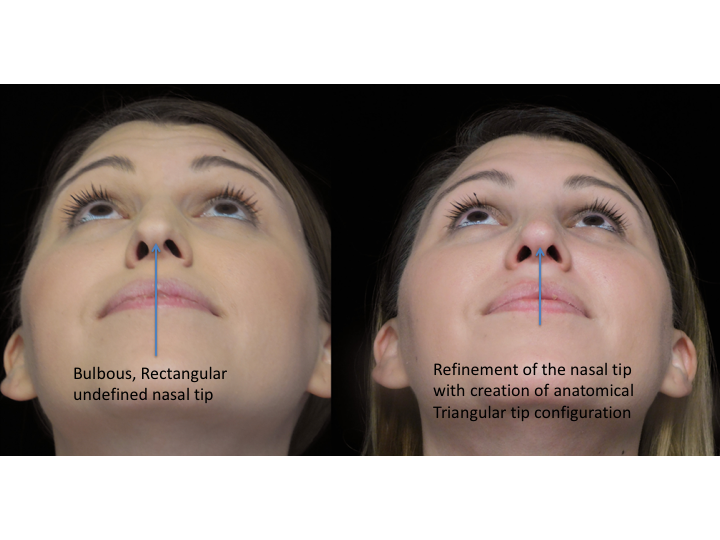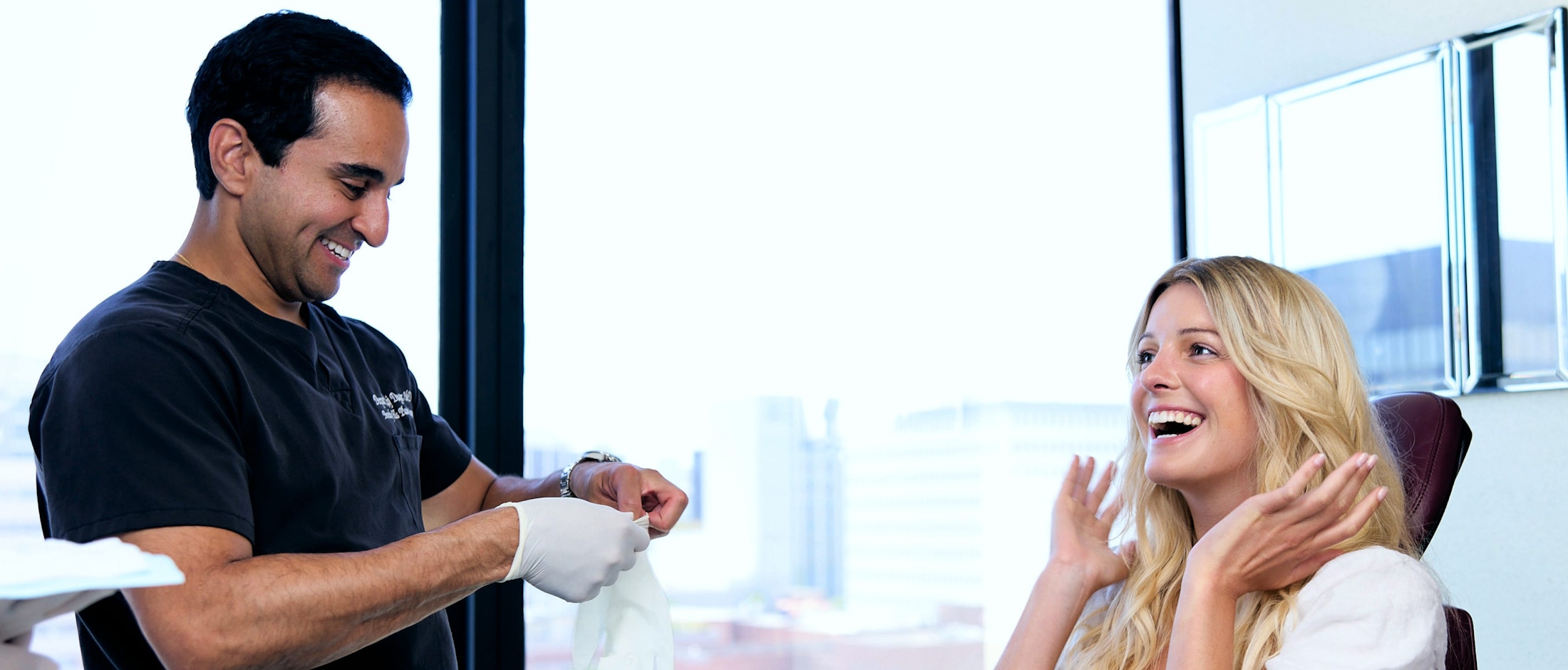Rhinoplasty is a surgical facial procedure performed to change the shape of the nose. It could be done for cosmetic reasons or for medical purposes, typically to improve the nose’s function by opening blocked nasal passages to correct existing breathing problems. In most cases, it is performed with both cosmetic and functional purposes in mind.
Table Of Contents
Rhinoplasty is a surgical procedure performed to change the shape of the nose. It could be done for cosmetic reasons or for medical purposes (e.g., opening blocked nasal passages to correct existing breathing problems). In many cases, it is performed with both cosmetic and functional purposes in mind.
Colloquially known as a “nose job,” rhinoplasty enhances a patient’s nasal contours through surgery. It involves reforming the nasal bone and/or nasal cartilage to create a natural contour that enhances overall facial harmony.
Beverly Hills Rhinoplasty Center performs two types of procedures: closed rhinoplasty and functional rhinoplasty. Dr. Deepak Dugar uses a custom approach for each patient, taking into account their specific reasons for the procedure without compromising the nose’s structural support or nasal breathing.
In this article, we’ll take an in-depth look at the different types of rhinoplasty, how to prepare for the procedure, and the health benefits it can offer.
Should you undergo rhinoplasty?
The idea of facial harmony is the top motivating factor behind many cosmetic rhinoplasties. It’s the concept of having well-balanced facial features that are proportionate to one another.
As one of the face’s most prominent features, the nose plays a key role in creating that harmony. Many who undergo rhinoplasty are motivated because they feel their noses disrupt the overall balance of their face. They could be too big, overly crooked, or exuding a small but noticeable bump in the middle portion.
Through rhinoplasty, you may be able to:
- Refine the size of a large bulbous tip
- Adjust a crooked nose bridge
- Fix a crease in the nasal tip
- Smoothen a prominent bump on the bridge
- Reduce the length of an excessively protruding nasal tip
- Narrow down wide nasal bones
You can also have rhinoplasty performed to correct certain medical issues such as breathing problems, bone damage caused by an injury, chronic migraines, and even allergies.
For young patients who wish to undergo rhinoplasty for cosmetic reasons, the nasal bone must first be fully developed. For females, this is around 15 years of age. For males, it may come much later, since the nasal bone usually continues growing past the age of 15. If you need to undergo rhinoplasty due to a breathing impairment, however, the procedure can be performed earlier.
An experienced and skilled cosmetic surgeon such as Dr. Dugar will be able to explain what’s possible through rhinoplasty to help you achieve a nose that looks natural and balanced with your unique facial features.
Types of rhinoplasty
The kind of rhinoplasty procedure you get ultimately depends on your needs and the surgeon’s chosen technique. The recommended approach is based on several factors, including your nasal anatomy and desired outcome.
Here’s an in-depth look at the different types of rhinoplasty procedures:
Closed Rhinoplasty
Closed or endonasal rhinoplasty is a less invasive approach that does not require a significant opening— all necessary incisions are done inside the nostrils. Informally known as a “Scarless Nose® job,” this procedure involves lifting soft tissues of the nose slightly upward to give the surgeon access to the different features of the nose framework, including the septum, nasal cartilage, and bone.
The “closed” approach is commonly used for patients requiring nasal bridge adjustments and discreet shape or size modifications to the nose. Since it is less invasive, there is less risk for scarring. Furthermore, the procedure takes less time to complete, and the recovery period is significantly reduced. Once the nose is fully healed, the patient can enjoy better circulation and breathing patterns.
Closed rhinoplasty or Scarless Nose® job is highly recommended for those who want to achieve facial harmony. Key adjustments to the size, shape, or angle of the nose are all possible through this safe and less invasive approach.
Closed scarless rhinoplasty is the solution of choice for many patients at the Beverly Hills Rhinoplasty Center. Head to this page for the Center’s philosophy behind this specialized procedure.
Open Rhinoplasty
Open rhinoplasty is often performed on patients who require extensive nose reshaping or reduction.
During the procedure, the surgeon makes a few incisions in the columella, which is the thin layer of cartilage beneath the nose which delineates the left and right side. Once the incisions are made, the skin is lifted up to give the surgeon access to the nasal cartilage for reshaping.
After performing the adjustments, incisions on the columella are sutured, and the nose is secured in place with a splint and some tape. The splint will be needed to ensure the nose stays in place throughout the duration of the healing process.
Open rhinoplasty is an ideal option for individuals who suffer from structural or genetic deformities as well as injuries that require grafting. In other cases, open rhinoplasty is also required to correct the results of a previous rhinoplasty.
Secondary or revision rhinoplasty
Secondary or revision rhinoplasties are corrective procedures that are performed primarily to modify the form and/or function of the nose following a previous rhinoplasty. Some of the specific reasons that warrant corrective procedure include:
- Repair any cosmetic or functional issues that were not properly treated by a previous surgeon.
- Reduce or tone down the appearance of a nose that’s been excessively changed.
- Address persisting imbalances from an earlier revision procedure
- Unexpected healing complications that occur during the recovery period of a first-time procedure
A secondary rhinoplasty can be performed either through the “open” or “closed” rhinoplasty approach depending on the patient’s needs. Cases that require major structural alterations often need the open approach, while the closed approach can be used for minor corrections or cosmetic purposes.
Non-surgical (liquid) or filler rhinoplasty
Non-surgical rhinoplasty is an alternative to traditional rhinoplasty. It is often used to address specific issues such as a drooping nasal tip or dorsal hump. The procedure involves injecting fillers into the nose in order to reshape and refine its appearance.
Under the expert hands of Dr. Dugar, a non-surgical liquid rhinoplasty procedure at the Beverly Hills Rhinoplasty Center only takes 10 minutes to complete. Patients can also enjoy immediate results and a shorter recovery period.
Dr. Dugar uses safe reversible hyaluronic acid-based fillers such as Juvederm to contour the nose, concealing irregularities or masking subtle bumps for patients who may be unable or unwilling to undergo plastic surgery. The results last anywhere from one to three years.
For more information about Liquid Non-Surgical Rhinoplasty offered at Beverly Hills Rhinoplasty Center, visit this page.
Tips for rhinoplasty preparation and recovery
Taking a few simple steps to stay healthy in the weeks prior to and following a rhinoplasty surgery will help enable a good recovery. Here are a few tips for you to keep in mind as you prepare for the procedure which will allow you to get a head start on your recovery period.
Before and after the procedure
- Maintain a balanced diet and nutrition regimen – Improve digestion by increasing your intake of high-fiber food. This will lower the risk of constipation that may occur after post-operative anesthetics and medications. Intake of iron supplements and vitamin C will also help expedite the healing process.
- Drink more water – Aim to drink twice as much water as you normally do on a daily basis. Increased water intake will improve your body’s ability to heal scars, which is key when recovering from any type of surgery.
- Wash your face twice a day – Use mild soap or a gentle cleanser and exfoliate at least every other day to get rid of dead skin. Light moisturizer is also recommended. While this might be something you’ve already been doing regularly, a week or two before a rhinoplasty surgery is the right time to take it extra seriously. Keep in mind that you’ll have a cast over your nose for a week or more, so you may not be able to wash your face as thoroughly as you’d like post-surgery.
- Maintain a healthy sleep schedule – Try to get at least eight hours of sleep days before the procedure, and take short naps during the day if you can as well. This will encourage your body and mind to acclimate to resting during the day, as you will need to keep activity levels to a minimum after surgery.
- MRequest at least one to two weeks off from your job – The healing period following the procedure depends on various factors, including the amount of reconstruction done and the specific surgical method used. If possible, request at least one to two weeks off from work to rest. Depending on the type of work you do, you may resume normal activity after the sutures and the cast are removed.
- MArrange for transportation and care – You should feel relaxed and stress-free on the day of your surgery, so make sure logistics are ironed out. You may already be aware that you’ll be unable to drive after the procedure, so be sure to request assistance from someone willing to help, such as your significant other, sibling, or friend. Having this person stay with you for at least the first day of recovery is required, so you’ll have someone to help you prepare your meals, take medication, and address additional needs.
What to avoid
- Alcohol – Alcohol can dehydrate you, lower your body’s immune system, and impair your recovery following the surgery.
- Cigarettes – Refrain from smoking cigarettes the week prior to your procedure and during recovery, as tobacco and nicotine consumption will compromise your body’s ability to heal.
- Cosmetic products – Do not use any cosmetic products on your face or hair on the day of the procedure. Remember to wash your face thoroughly to eliminate bacteria and debris.
- Certain supplements and medications – Avoid taking supplements and medications such as aspirin, vitamin E supplements, NSAIDs, or herbal medications like ginseng, as these may interfere with anesthesia. Consult Dr. Dugar to inquire about the types of medications and supplements you should avoid before the procedure, or download the guide attached below.
- Prolonged sun exposure – Prolonged exposure to UV light can damage your skin and can complicate the recovery process, so try to stay indoors or within shaded areas as much as possible after the procedure.
- Strenuous activity – Light walking and other very low-impact exercises are recommended after rhinoplasty surgery. Vigorous exercises such as running, jumping or weightlifting however, should be avoided for at least six weeks for proper recovery.
For a complete list of pre- and post-operative instructions, download this comprehensive guide.
Health benefits of rhinoplasty
While facial harmony and enhanced aesthetic appeal are primary motivators for most people, rhinoplasty also offers several long-term health benefits. These include:
- Therapeutic benefits – The nose is a key part of our respiratory system, working together with the mouth for oxygen intake and the release of carbon dioxide. Rhinoplasty can unblock or widen airways, improving a person’s breathing patterns and overall breathing quality.
- Reduced sinus pressure – Sinus problems are often caused by blocked or congested cavities between facial bones, particularly surrounding the nose, the upper cheeks, and the forehead. This leads to pressure build-up in the sinuses, often felt as a heavy, debilitating type of pain, resulting in migraines in many cases. There’s a risk of bacteria getting trapped within these spaces too, which often leads to infection. Through rhinoplasty, changes can be performed on the nasal septum in order to alleviate sinus problems. That said, please consult a sinus specialist for further advice as well.
- Better sleep quality – Blocked or restricted airflow is a problem in its own right. It can become a complicating factor that leads to other health conditions. Snoring is a telltale symptom of major sleep disorders such as obstructive sleep apnea (OSA), which can be aggravated by restricted airflow. Rhinoplasty is an ideal solution for patients who have difficulty passing air through their noses, improving their chances of getting more restful sleep.
- Improved exercise – Exercising regularly is one of the best ways to stay healthy, but it can be more difficult and less enjoyable for those who have difficulty breathing. Rhinoplasty can solve any pre-existing breathing issues caused by obstructed nasal airways, which makes the respiratory system more efficient — thus improving the overall quality of exercise.
- Reduced frequency of upper respiratory infections – A clogged nose disrupts a person’s breathing pattern, which can adversely affect the structure of the jaw due to frequent breathing through the mouth. Through rhinoplasty, adjustments made to the inner part of the nose will promote a healthier, more stable breathing pattern, effectively reducing the occurrence of upper respiratory tract infections.
Before and after a rhinoplasty procedure
Results from rhinoplasty surgeries are permanent, although it can typically take one to three years for the nasal contour to completely refine after a procedure. Proper care of your newly operated nose and maintaining a healthy lifestyle is the best way to take care of the results of your new appearance.
To view more featured results from the Beverly Hills Rhinoplasty Center visit this page.
The cost
As with other types of cosmetic surgeries, the total cost of a rhinoplasty procedure depends on the region, the physician, and other variables such as whether it’s an open or closed procedure or if it’s a primary or revision surgery.
If you require a highly in-demand surgeon to perform a Scarless Nose® job, the price for the procedure may be higher, especially if the main purpose is to correct unsightly changes made to the nose. Schedule a consultation today for more information on cost.
Scarless Nose®; Closed Rhinoplasty by Dr. Deepak Dugar
Doctor Deepak Dugar is one of the only Board Certified Rhinoplasty Surgeons in the US who has dedicated his entire surgical practice to closed rhinoplasty. He is a recipient of the Top 10 Plastic Surgeon Award by the National Academy of Plastic Surgeons. He is a respected authority within the industry, with his research published in various internationally acclaimed peer-reviewed journals. Dr. Dugar also lectures at national medical conferences throughout the country, and is a key member of the advisory board for different medical device and technology companies in the US.
By devoting his entire career to the mastery of closed rhinoplasty or Scarless Nose® surgery, he has delivered exceptional results for countless patients and A-list clientele, which include celebrities, models, athletes, and other high-profile personalities.
Interested in exploring Scarless Nose®; Closed Rhinoplasty further? Book a consultation with Dr. Dugar today by visiting this page.


